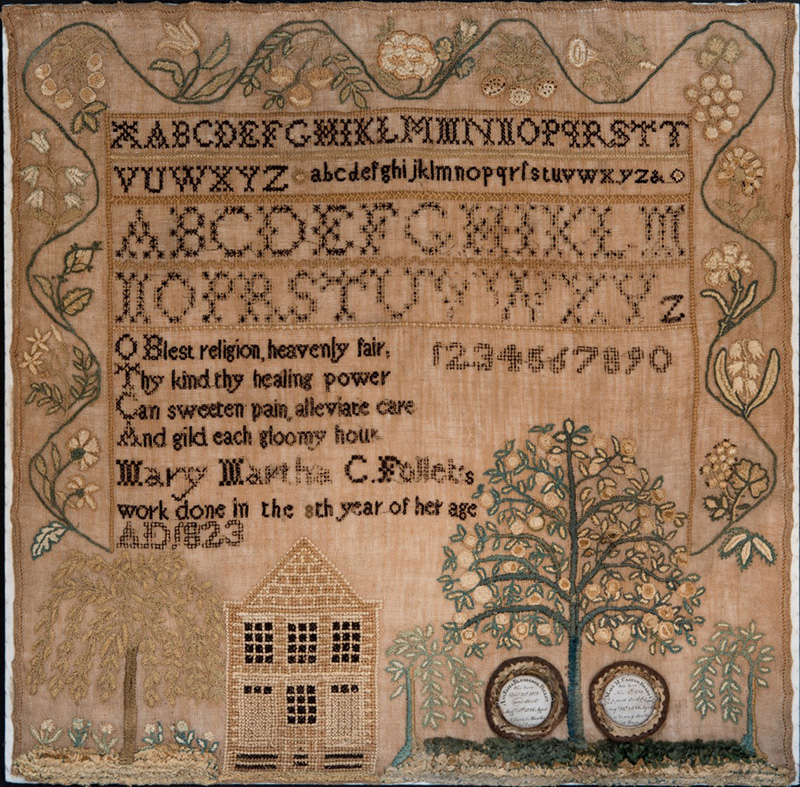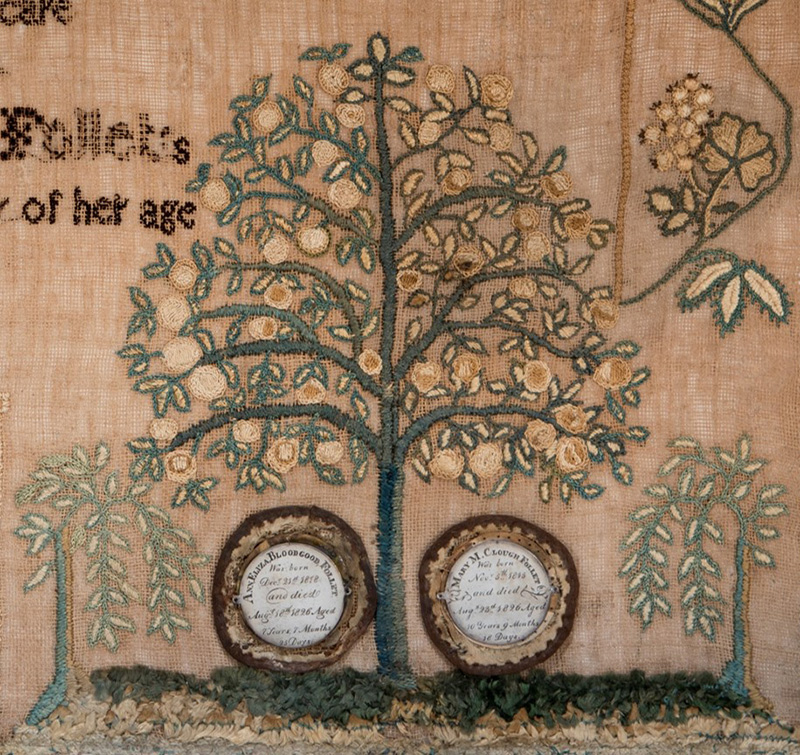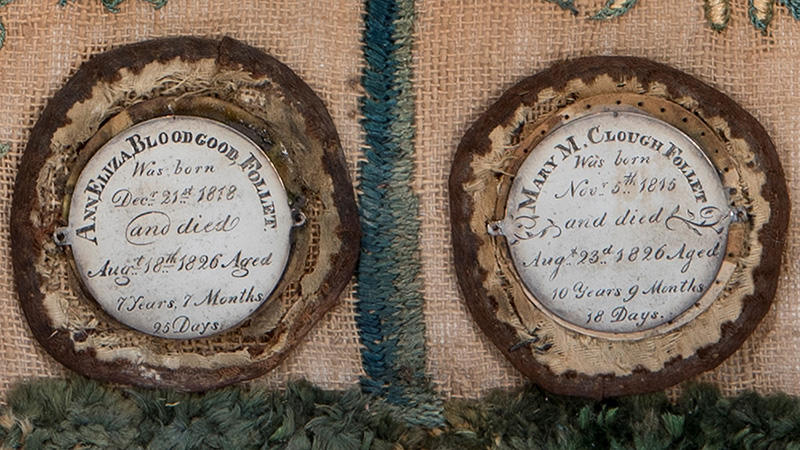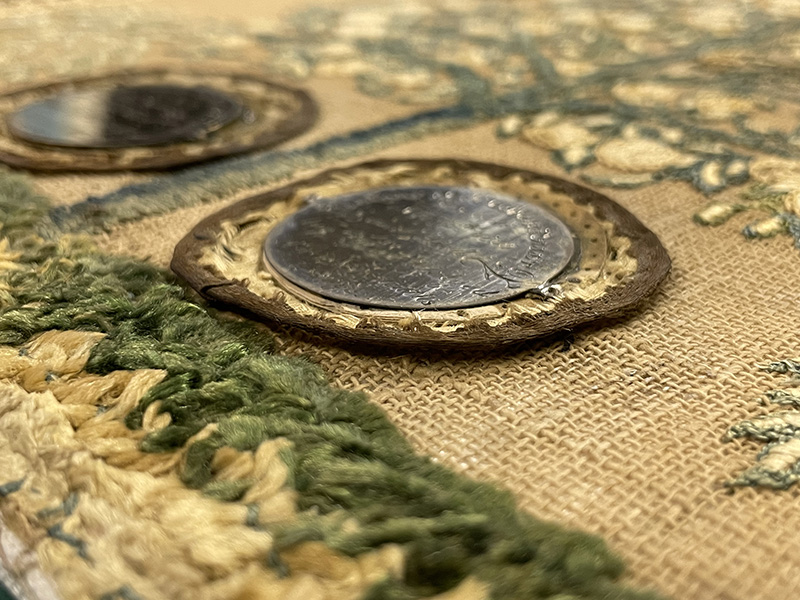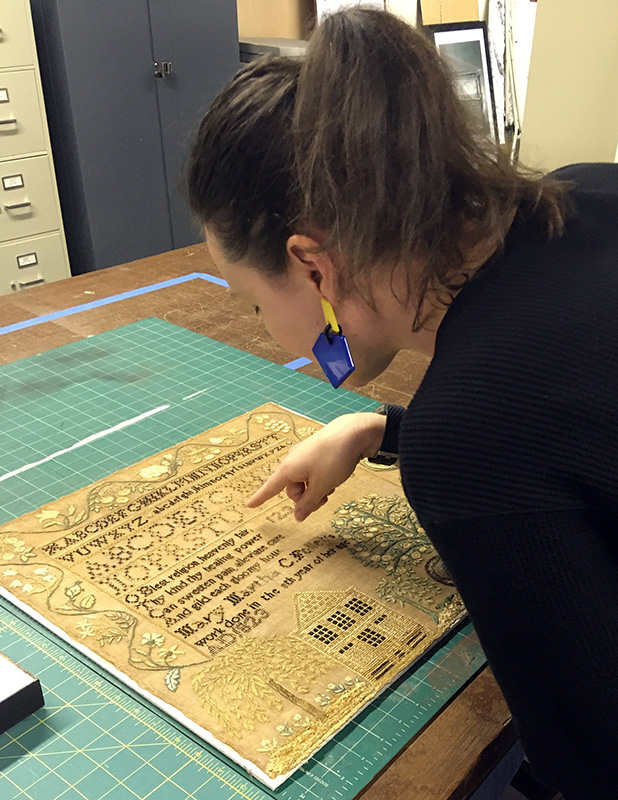The Follet Sampler at the Museum of Early Southern Decorative Arts
by Alexandra M. Macdonald
The Follet sampler (figure 1), hanging in an unassuming hallway at the Museum of Early Southern Decorative Arts (MESDA) in Winston-Salem, NC, could easily go unnoticed. At a passing glance, it includes all the things we expect to find in an early-19th-century schoolgirl sampler. Eight-year-old Mary Martha C. Follet stitched three alphabets, the numbers zero through nine, the opening verse to “Religion,” a two-story brick building, her name and age, and the date. At times, she made small mistakes in her stitches, thread choice, and design, but elegantly executed flowers and fruit frame her work as they weave and twist their way around the edges of the linen. Each of these elements tells us something about the sampler, but it is the design in the lower right corner of the work that makes this piece remarkable. At the base of a flowering tree are two shimmering silver disks engraved with Mary and her younger sister Ann’s ages and birth and death dates (figures 2, 3, and 4). They are flanked on either side by weeping willows whose branches curve inwards as if reaching out towards the objects they frame. Functioning like tiny tombstones, these disks stop you in your tracks.
Supported by a Decorative Arts Trust Research Grant, I was able to conduct research into the sampler in the MESDA collection and at the Library of Virginia in Richmond. While my research is far from complete, I posit that all four members of the Follet family—Francis, Eliza, Mary, and Ann—are represented in this unique embroidery. We can see Mary’s tentative first steps into her education cut short by the abrupt end to her life in the summer of 1826. Her father, Francis, appears in the stitched façade of his shop and in the silver disks he engraved to memorialize the deaths of his only children. Eliza, the girl’s mother, is present in the sampler as her hands finish what Mary began; she stitched the flowering fruit tree and the two weeping willows on either side of the engraved silver disks (figure 2), and she may have stitched the floral border. Ann has been symbolically laid to rest beside her older sister. Each of these interventions shape how we read the sampler.
Currently, there is no identified grouping of Petersburg samplers. This makes it difficult to use the stylistic elements of the Follet sampler to link Mary’s work to a school or a specific teacher. There were, however, a number of schools operating in Petersburg in the early 19th century. In 1819, for example, Jonathan Smith placed an advertisement in the Petersburg Republican to “respectfully inform” the public that the Petersburg Female Seminary was “prepared to instruct young ladies in various branches of education usually taught in female seminaries.” This instruction included reading, writing, mathematics, modern geography, and “the various kinds of plain and ornamental needle work.” When Mary began her sampler, at the Female Seminary or elsewhere, her small hands learned the repetitious movements needed to create her embroidery. She believed she was crafting an object that would be the first step in her education. Instead, the sampler became her memorial.
It is impossible to know how Eliza and Francis felt in August of 1826 when they lost their only children. What we do have is evidence of how they worked through their grief materially. It was not uncommon for a family member to complete a sampler after the death of the original stitcher. What is unique is the precious mixed media of silver and silk. Francis’s disks demand our attention. They beckon to us and ask us to make sense of their presence on the sampler. Stylistically, the careful balance of text on silver is reminiscent of tombstones from the first half of the 19th-century. It is possible that these two silver disks stood in for the tombstones themselves. Flanked by Eliza’s weeping willows, well-established symbols of loss and mourning in the 19th-century, these disks and the larger mourning scene Eliza has created around them transforms the embroidery from a schoolgirl sampler into a site of family memory and mourning.
With the Trust’s support, I thought deeply about the Follet sampler to consider how it fits together with the other material evidence of time, loss, and memory I am exploring as part of my dissertation project about non-mechanical timekeepers such as embroideries, paintings, and metal goods. While ultimately a memorial for Mary and Ann, this rare and unique sampler is a family archive contained within a single square of linen. It simultaneously extends Eliza and Francis’s time with their daughters and captures a singular moment in time. Working with this sampler led me to reconsider my assumptions about how material objects mediate our relationships with life, death, and the deceased. Objects can evoke the presence of a person and, in this process of evocation, they become reliquaries of memory.
- Originally from upstate New York, Francis first appears in Richmond in the first decade of the 19th century working as a jeweler and running an iron mongery. By 1811 he had moved to Petersburg where he placed an ad for his iron mongery and hardware store. He appears to have formed a number of unsuccessful partnerships in both Richmond and Petersburg, but by the time Mary was stitching her sampler he was selling a variety of metal goods ranging from silver to iron.
- Kimberly Smith Ivey, In the Neatest Manner: The Making of the Virginia Sampler Tradition (Williamsburg, VA: Curious Works Press & The Colonial Williamsburg Foundation, 1997).
- 3. Petersburg Republican, Va. 20 Dec 1819, 2-6.
Alexandra M. Macdonald is a PhD candidate in the Department of History at William & Mary. She received a 2021 Research Grant from the Decorative Arts Trust.
A print version of this article was published in The Magazine of the Decorative Arts Trust, one of our most popular member benefits. Join today!

